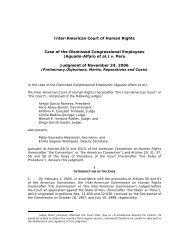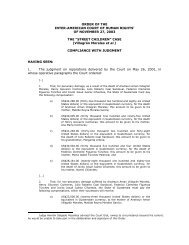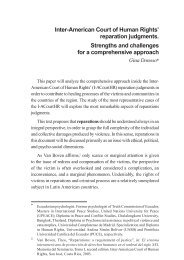The Political Economy of Japan Bradley M. RICHARDSON
The Political Economy of Japan Bradley M. RICHARDSON
The Political Economy of Japan Bradley M. RICHARDSON
- No tags were found...
Create successful ePaper yourself
Turn your PDF publications into a flip-book with our unique Google optimized e-Paper software.
every five <strong>of</strong> <strong>Japan</strong>ese workers were affected. Medium and small businesses, many<strong>of</strong> which were chronically weak financially (although some also did quite well throughmodernization programs), also received a substantial amount <strong>of</strong> government supportthroughout much <strong>of</strong> the postwar era.<strong>The</strong> magnitude <strong>of</strong> attention given weak and sick industries by <strong>Japan</strong>'spostwar governments is shown by the numbers <strong>of</strong> major policies and amounts <strong>of</strong>resources allocated to address their problems. Figure 6 shows the numbers <strong>of</strong> MITIplans and programs dedicated to growth industries contrasted -with proposedsolutions for problem sectors, and thus indicates in a rough sense the degree <strong>of</strong>policy concern for each area. <strong>The</strong> source is annual ministry policy reports. Table 6 inturn shows the amounts <strong>of</strong> FILP program funds allocated to small business loanscompared with lending to large business. Quite a bit <strong>of</strong> the financial support givensmall business addressed temporary or long-term economic woes in particular smallfirm sectors. Substantial funds were also supplied for modernization <strong>of</strong> small firmsthrough the introduction <strong>of</strong> automated equipment and other improvements. <strong>The</strong> twogoals are not mutually exclusive.What is striking about these two sets <strong>of</strong> data is how much attention has beenpaid to less economically promising economic sectors compared with support forsuccessful industries. Almost as much attention was paid to problem industries as togrowth sectors. One hundred twenty five growth programs were cited in annualministry reports between 1955 and 1980, but there were also 109 recession policies.If the purpose <strong>of</strong> market interventions, a third category <strong>of</strong> MITI actions in ourinformation, was known in all instances, recession programs might outnumber growthframeworks (107).Quantitative data on allocations <strong>of</strong> FILP loans to "basic industries" (the largefirm growth sector) and medium and small businesses tell a similar story. By themid-1960s <strong>Japan</strong>ese governments were spending twice as much or more on smallbusiness as on large firm development. Later even larger disparities could beobserved. Although it is true that not all small businesses were economic disasters,many small business programs were remedial in nature. One might conclude that<strong>Japan</strong>'s role as an "economic welfare" state is as important as its role as a"developmental state".Information from the 1960s and 1970s regarding the timing <strong>of</strong> governmentloans relative to production growth and value added in the production process (Table7) tells a similar story as to the relationship between industry success or failure andgovernment policy response. In industries like automobiles, precision instrumentsand consumer electronics the proportion <strong>of</strong> <strong>Japan</strong> Development Bank loansremained low throughout the postwar era. Borrowing from the JDB also declined inmost periods relative to both gross output and value added, which implies that firms
















